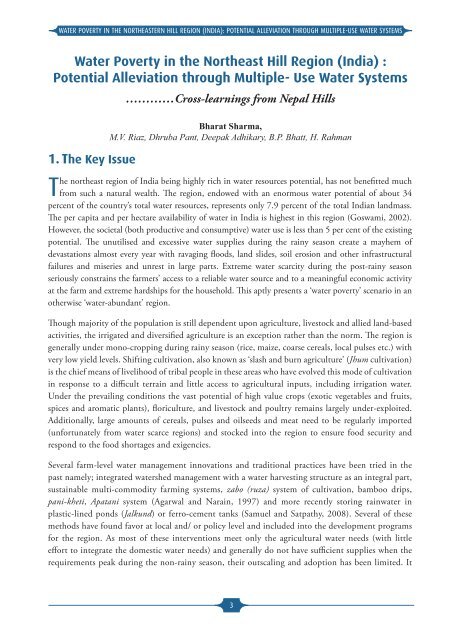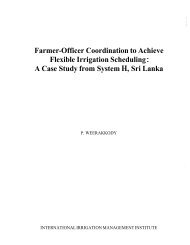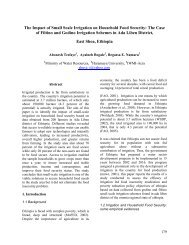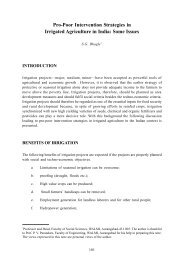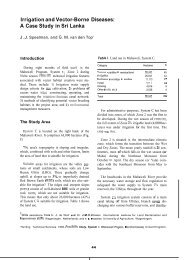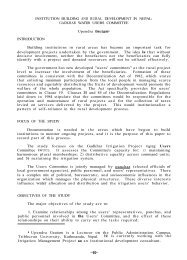WATER POVERTY IN THE NORTHEASTERN HILL REGION (INDIA)
WATER POVERTY IN THE NORTHEASTERN HILL REGION (INDIA)
WATER POVERTY IN THE NORTHEASTERN HILL REGION (INDIA)
You also want an ePaper? Increase the reach of your titles
YUMPU automatically turns print PDFs into web optimized ePapers that Google loves.
<strong>WATER</strong> <strong>POVERTY</strong> <strong>IN</strong> <strong>THE</strong> NOR<strong>THE</strong>ASTERN <strong>HILL</strong> <strong>REGION</strong> (<strong>IN</strong>DIA): POTENTIAL ALLEVIATION THROUGH MULTIPLE-USE <strong>WATER</strong> SYSTEMSWater Poverty in the Northeast Hill Region (India) :Potential Alleviation through Multiple- Use Water Systems1. The Key Issue…………Cross-learnings from Nepal HillsBharat Sharma,M.V. Riaz, Dhruba Pant, Deepak Adhikary, B.P. Bhatt, H. RahmanThe northeast region of India being highly rich in water resources potential, has not benefitted muchfrom such a natural wealth. The region, endowed with an enormous water potential of about 34percent of the country’s total water resources, represents only 7.9 percent of the total Indian landmass.The per capita and per hectare availability of water in India is highest in this region (Goswami, 2002).However, the societal (both productive and consumptive) water use is less than 5 per cent of the existingpotential. The unutilised and excessive water supplies during the rainy season create a mayhem ofdevastations almost every year with ravaging floods, land slides, soil erosion and other infrastructuralfailures and miseries and unrest in large parts. Extreme water scarcity during the post-rainy seasonseriously constrains the farmers’ access to a reliable water source and to a meaningful economic activityat the farm and extreme hardships for the household. This aptly presents a ‘water poverty’ scenario in anotherwise ‘water-abundant’ region.Though majority of the population is still dependent upon agriculture, livestock and allied land-basedactivities, the irrigated and diversified agriculture is an exception rather than the norm. The region isgenerally under mono-cropping during rainy season (rice, maize, coarse cereals, local pulses etc.) withvery low yield levels. Shifting cultivation, also known as ‘slash and burn agriculture’ (Jhum cultivation)is the chief means of livelihood of tribal people in these areas who have evolved this mode of cultivationin response to a difficult terrain and little access to agricultural inputs, including irrigation water.Under the prevailing conditions the vast potential of high value crops (exotic vegetables and fruits,spices and aromatic plants), floriculture, and livestock and poultry remains largely under-exploited.Additionally, large amounts of cereals, pulses and oilseeds and meat need to be regularly imported(unfortunately from water scarce regions) and stocked into the region to ensure food security andrespond to the food shortages and exigencies.Several farm-level water management innovations and traditional practices have been tried in thepast namely; integrated watershed management with a water harvesting structure as an integral part,sustainable multi-commodity farming systems, zabo (ruza) system of cultivation, bamboo drips,pani-kheti, Apatani system (Agarwal and Narain, 1997) and more recently storing rainwater inplastic-lined ponds (Jalkund) or ferro-cement tanks (Samuel and Satpathy, 2008). Several of thesemethods have found favor at local and/ or policy level and included into the development programsfor the region. As most of these interventions meet only the agricultural water needs (with littleeffort to integrate the domestic water needs) and generally do not have sufficient supplies when therequirements peak during the non-rainy season, their outscaling and adoption has been limited. It3


